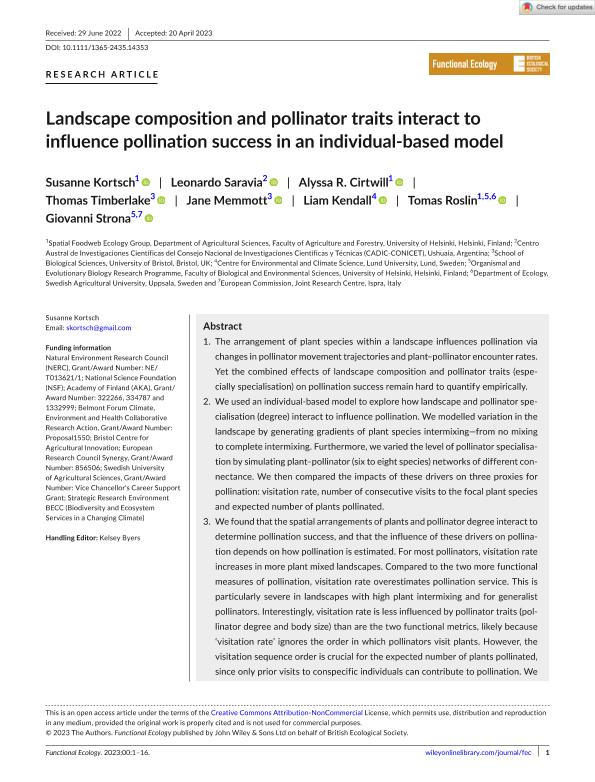Artículo
Landscape composition and pollinator traits interact to influence pollination success in an individual-based model
Kortsch, Susanne; Saravia, Leonardo Ariel ; Cirtwill, Alyssa R.; Timberlake, Thomas; Memmott, Jane; Kendall, Liam; Roslin, Tomas; Strona, Giovanni
; Cirtwill, Alyssa R.; Timberlake, Thomas; Memmott, Jane; Kendall, Liam; Roslin, Tomas; Strona, Giovanni
 ; Cirtwill, Alyssa R.; Timberlake, Thomas; Memmott, Jane; Kendall, Liam; Roslin, Tomas; Strona, Giovanni
; Cirtwill, Alyssa R.; Timberlake, Thomas; Memmott, Jane; Kendall, Liam; Roslin, Tomas; Strona, Giovanni
Fecha de publicación:
07/2023
Editorial:
Wiley Blackwell Publishing, Inc
Revista:
Functional Ecology
ISSN:
0269-8463
Idioma:
Inglés
Tipo de recurso:
Artículo publicado
Clasificación temática:
Resumen
The arrangement of plant species within a landscape influences pollination via changes in pollinator movement trajectories and plant–pollinator encounter rates. Yet the combined effects of landscape composition and pollinator traits (especially specialisation) on pollination success remain hard to quantify empirically. We used an individual-based model to explore how landscape and pollinator specialisation (degree) interact to influence pollination. We modelled variation in the landscape by generating gradients of plant species intermixing—from no mixing to complete intermixing. Furthermore, we varied the level of pollinator specialisation by simulating plant–pollinator (six to eight species) networks of different connectance. We then compared the impacts of these drivers on three proxies for pollination: visitation rate, number of consecutive visits to the focal plant species and expected number of plants pollinated. We found that the spatial arrangements of plants and pollinator degree interact to determine pollination success, and that the influence of these drivers on pollination depends on how pollination is estimated. For most pollinators, visitation rate increases in more plant mixed landscapes. Compared to the two more functional measures of pollination, visitation rate overestimates pollination service. This is particularly severe in landscapes with high plant intermixing and for generalist pollinators. Interestingly, visitation rate is less influenced by pollinator traits (pollinator degree and body size) than are the two functional metrics, likely because ‘visitation rate’ ignores the order in which pollinators visit plants. However, the visitation sequence order is crucial for the expected number of plants pollinated, since only prior visits to conspecific individuals can contribute to pollination. We show here that this order strongly depends on the spatial arrangements of plants, on pollinator traits and on the interaction between them. Taken together, our findings suggest that visitation rate, the most commonly used proxy for pollination in network studies, should be complemented with more functional metrics which reflect the frequency with which individual pollinators revisit the same plant species. Our findings also suggest that measures of landscape structure such as plant intermixing and density—in combination with pollinators' level of specialism—can improve estimates of the probability of pollination. Read the free Plain Language Summary for this article on the Journal blog.
Archivos asociados
Licencia
Identificadores
Colecciones
Articulos(CADIC)
Articulos de CENTRO AUSTRAL DE INVESTIGACIONES CIENTIFICAS
Articulos de CENTRO AUSTRAL DE INVESTIGACIONES CIENTIFICAS
Citación
Kortsch, Susanne; Saravia, Leonardo Ariel; Cirtwill, Alyssa R.; Timberlake, Thomas; Memmott, Jane; et al.; Landscape composition and pollinator traits interact to influence pollination success in an individual-based model; Wiley Blackwell Publishing, Inc; Functional Ecology; 37; 7; 7-2023; 2056-2071
Compartir
Altmétricas



